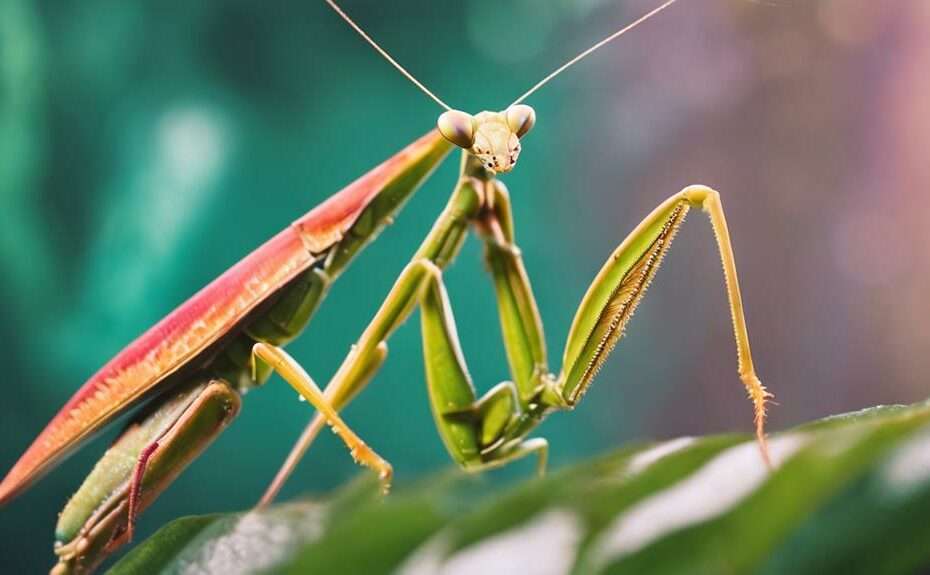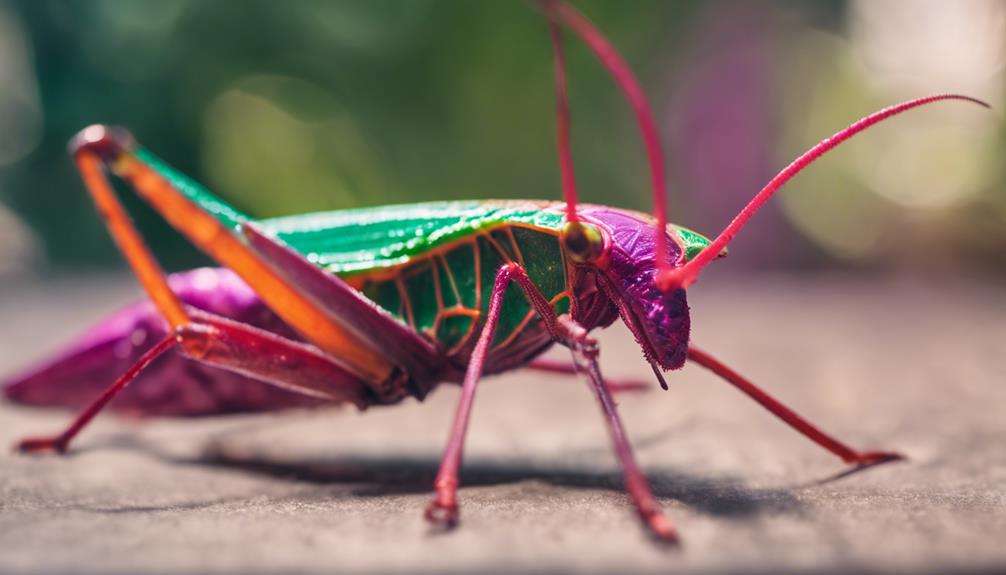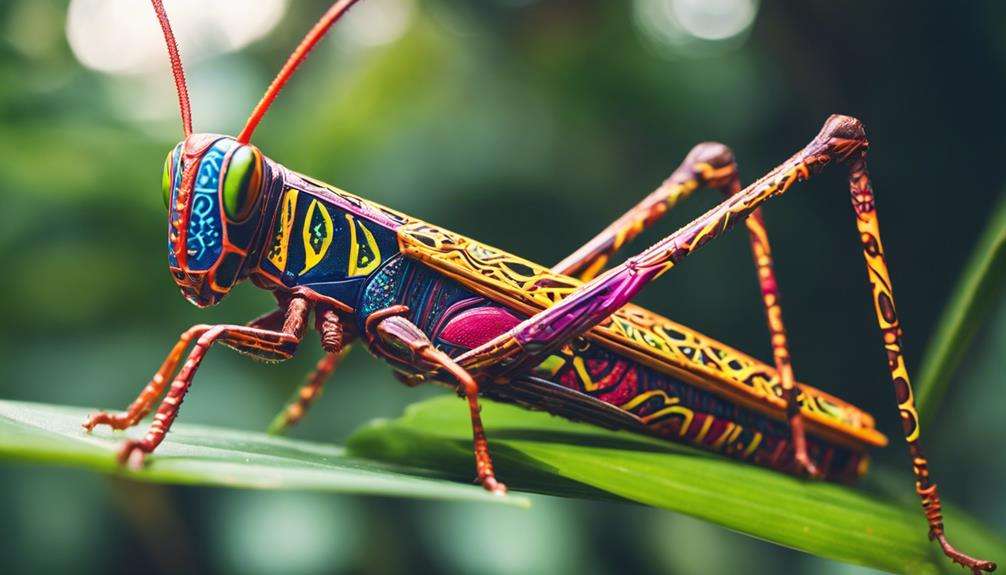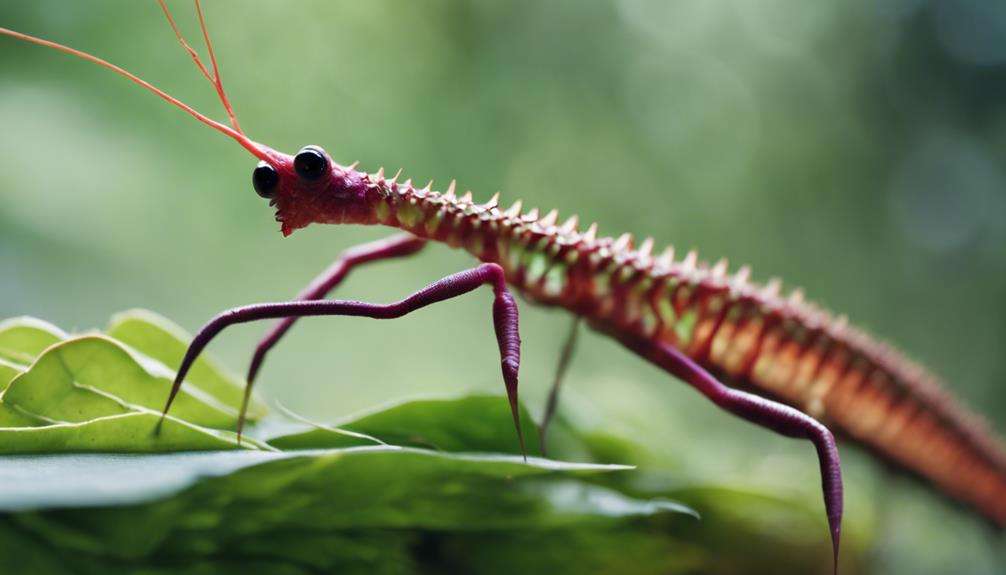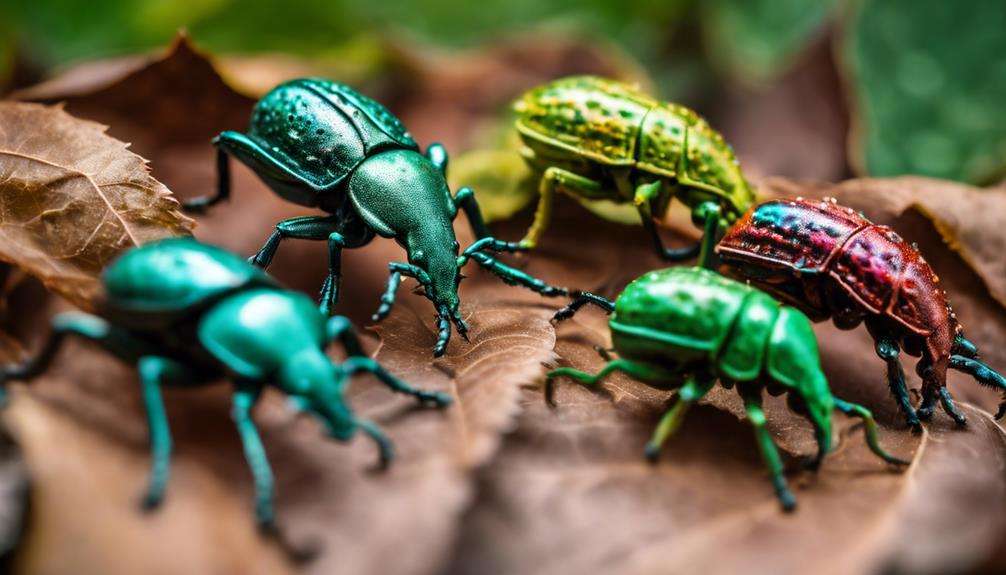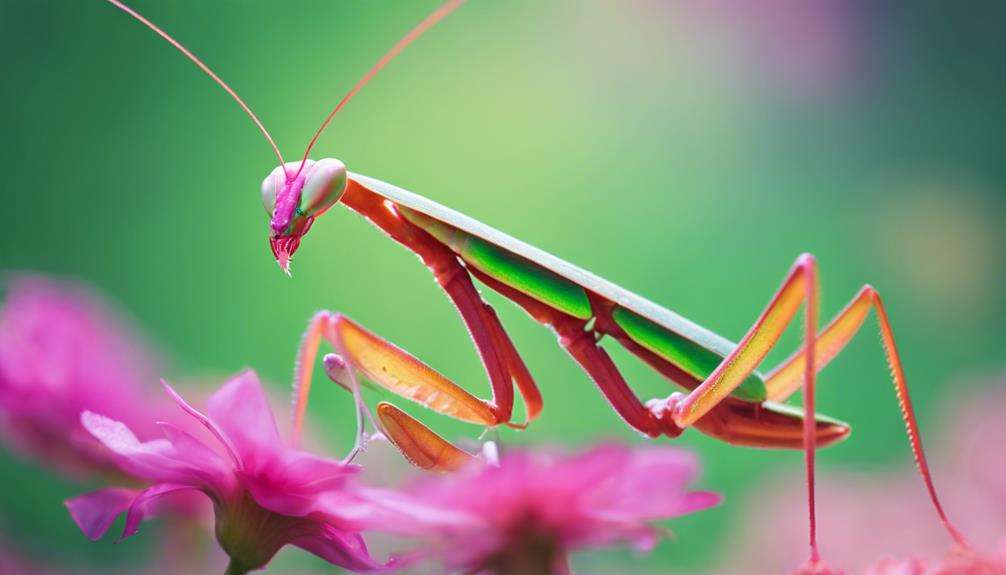If you're seeking a unique twist to your pet collection, exploring the realm of intriguing insects could offer a refreshing change. From the intricately patterned beetles to the graceful predators like praying mantises, there are fascinating options waiting to be discovered.
Each insect brings its own charm and allure, making them stand out as captivating companions in the world of unconventional pets. So, why not consider adding a touch of nature's marvels to your household with these intriguing insect friends?
Key Takeaways
- Beetle pets offer diverse colors and feeding habits, showcasing intricate behaviors and unique camouflage patterns.
- Praying mantises and stick insects require minimal maintenance, showcasing stunning appearances and remarkable camouflage skills.
- Isopods add visual interest to terrariums, aiding in waste decomposition with specific care needs for a thriving environment.
- Leaf insects and millipedes mimic leaves and feed on plant matter, requiring spacious terrariums and specialized care for their well-being.
Unique Beetle Pets
For those intrigued by the world of entomology, exploring unique beetle pets can provide a fascinating glimpse into the diverse and captivating realm of these insects. Beetles, with over 350,000 species available as pets, showcase a wide array of colorful patterns on their bodies. These intricate designs not only serve as a form of camouflage but also enhance their aesthetic appeal as captivating pets.
Observing beetles in captivity allows for a closer look at their feeding habits, which can vary greatly among species. Some beetles feed on plants, while others consume fungi or even other insects, showcasing their diverse dietary preferences. Additionally, beetles exhibit captivating behaviors that range from intricate mating rituals to fascinating interactions with their environment.
Keeping beetles as pets can be a rewarding experience due to their beauty, interesting feeding habits, and captivating behaviors, making them an intriguing choice for enthusiasts interested in the world of exotic insects.
Praying Mantis as Pets
Skillfully camouflaging themselves in their surroundings, praying mantises are captivating predators renowned for their distinctive triangular heads and lightning-fast reflexes. Praying mantises, known for their predatory nature, make excellent pets for insect enthusiasts.
These unique creatures require minimal maintenance, primarily feeding on a diet of moths, crickets, grasshoppers, and flies. One intriguing aspect of praying mantises is their ability to hiss when feeling threatened, adding to their mystique. Among the various species available, the orchid mantis stands out for its visually stunning appearance, captivating those who choose it as a pet.
Despite their cannibalistic tendencies, which serve as a form of natural population control, praying mantises can be housed individually in a suitable enclosure. Their fascinating behaviors, including their hunting techniques and agile movements, make them a delightful addition to any insect lover's collection.
If you're looking for a low-maintenance pet with unique characteristics, a praying mantis could be the perfect choice.
Unusual Isopod Companions
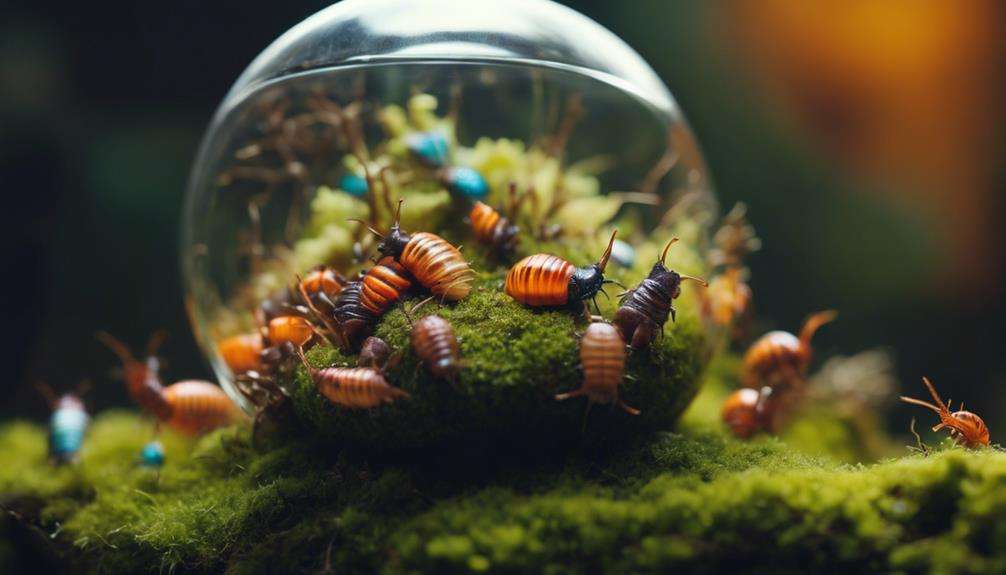
Isopods, also known as woodlice or pill bugs, are fascinating creatures that serve as excellent additions to terrarium ecosystems. Their varied species boast intricate patterns and colors, making them a visually captivating choice for hobbyists.
Providing these isopods with a humid environment and ample substrate is crucial for their well-being and reproduction success.
Isopod Species Overview
Exploring the diverse world of isopod species reveals a fascinating array of shapes, colors, and behaviors that make them intriguing companions for your terrarium. Isopods, though not insects, are unique pets that serve as valuable members of the terrarium ecosystem by aiding in waste decomposition.
Their wide range of color combinations and shapes, from the iridescent Porcellio hoffmannseggi to the striking Armadillidium gestroi, adds visual interest to your enclosure. With new varieties constantly emerging, the diversity available for isopod enthusiasts is ever-expanding.
These pets require a habitat with high humidity and deep substrate to thrive, making them excellent choices for those looking to create a bioactive setup. Specific species like the Shiro Utsuri Isopods showcase the unique and captivating nature of these creatures.
Isopod Care Tips
Regularly maintaining the humidity levels and substrate depth in your isopods' habitat is crucial for their optimal care and well-being. Isopods, being low-maintenance pets, thrive under specific conditions that mimic their natural environment. Here are essential care tips for your unusual isopod companions:
- Deep Substrate: Ensure a deep substrate layer in the habitat, as isopods burrow and forage within it, aiding in their natural behavior and providing hiding spots.
- High Humidity Levels: Isopods require a humid environment to prevent desiccation and facilitate proper molting processes. Mist the enclosure regularly to maintain adequate humidity levels.
- Monitoring Environment: Regularly check and adjust the temperature and humidity levels to create a stable and comfortable habitat for your isopods.
Isopod Enclosure Ideas
Maintaining an enriching environment for your isopods involves thoughtful consideration of their enclosure design to cater to their natural behaviors and well-being. Isopods can thrive in a variety of setups, ranging from simple plastic containers to elaborate terrarium arrangements.
Creating a moist environment by adding leaf litter and bark pieces replicates their natural habitat and supports their health. Live plants not only help regulate humidity levels but also enhance the aesthetic appeal of the enclosure, providing a more naturalistic setting for the isopods.
These creatures play a crucial role as bioactive cleaners, consuming decaying matter and contributing to the overall health of the terrarium ecosystem. Some isopod species, such as the visually striking Shiro Utsuri Isopod, can add a unique and captivating element to their enclosure.
Fascinating Stick Insect Pets
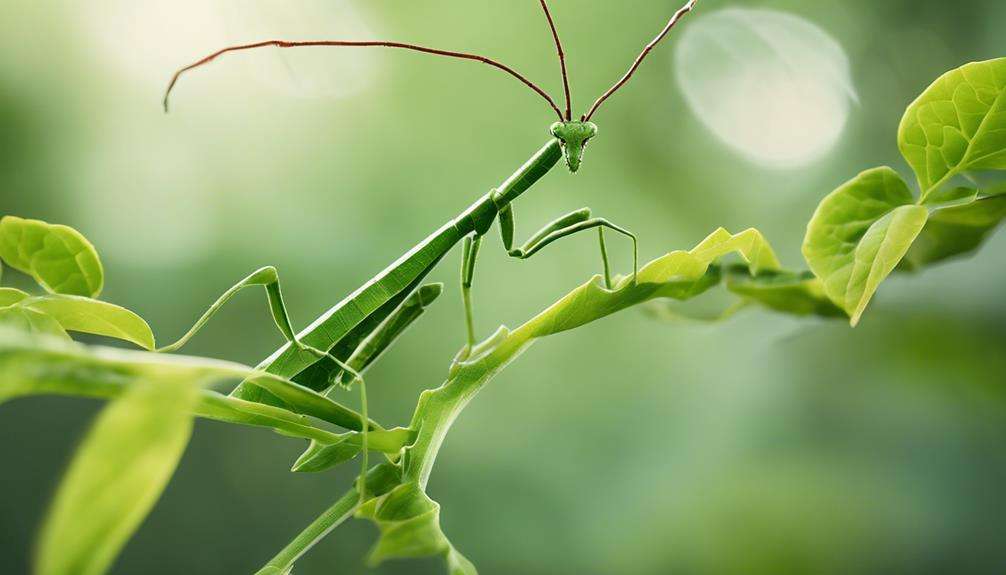
Stick insects encompass a wide array of species, each showcasing unique characteristics in their appearance and behavior.
Understanding the specific care and feeding requirements for your stick insect is crucial in maintaining their health and well-being.
When handling stick insects, it's essential to exercise caution and gentleness to avoid any accidental harm to these delicate creatures.
Stick Insect Varieties
Hidden among the foliage, fascinating Stick Insect Varieties showcase an array of sizes and intricate camouflage techniques that captivate observers.
- Stick insects, also known as stick bugs or leaf insects, exhibit a remarkable resemblance to their namesake objects, making them masters of disguise in their natural habitats.
- These insect pets vary in size, with some species measuring just a few inches while others can grow up to a foot in length, highlighting the diversity within this group.
- Their defense mechanism primarily relies on their ability to blend seamlessly with their surroundings, making them inconspicuous to predators and enabling them to evade detection.
Care and Feeding
Amidst the intricate world of Stick Insect Varieties lies a crucial aspect to their captivating allure – the meticulous care and feeding regimen required to ensure their well-being and longevity as fascinating insect pets. Stick insects, being herbivores, thrive on a diet of fresh leaves. Providing a variety of suitable leaves like bramble, oak, or rose will cater to their dietary needs. It's important to regularly check and replenish their food source to keep them healthy.
Additionally, ensuring a clean habitat with access to fresh water is essential for their well-being. Stick insects, ranging from a few inches to up to a foot in length, require gentle care due to their fragile nature. Their remarkable camouflage abilities make them appear like sticks or leaves, adding to their appeal as captivating pets.
Handling and Behavior
Concealed within the intricate tapestry of their environment, stick insects exhibit a remarkable array of behaviors that intrigue and captivate enthusiasts of these fascinating insect pets.
- Camouflage Mastery: Stick insects are masters of disguise, blending seamlessly with their surroundings to avoid detection by predators.
- Gentle Handling: Due to their fragile nature, stick insects require delicate handling to prevent injuries and stress.
- Woodlice Interaction: Woodlice, harmless insects that can be found in stick insect habitats, provide an interesting dynamic as they roll up into defensive balls when threatened, showcasing unique defensive behaviors that can be fascinating to observe.
Leaf Insects: Quirky Companions
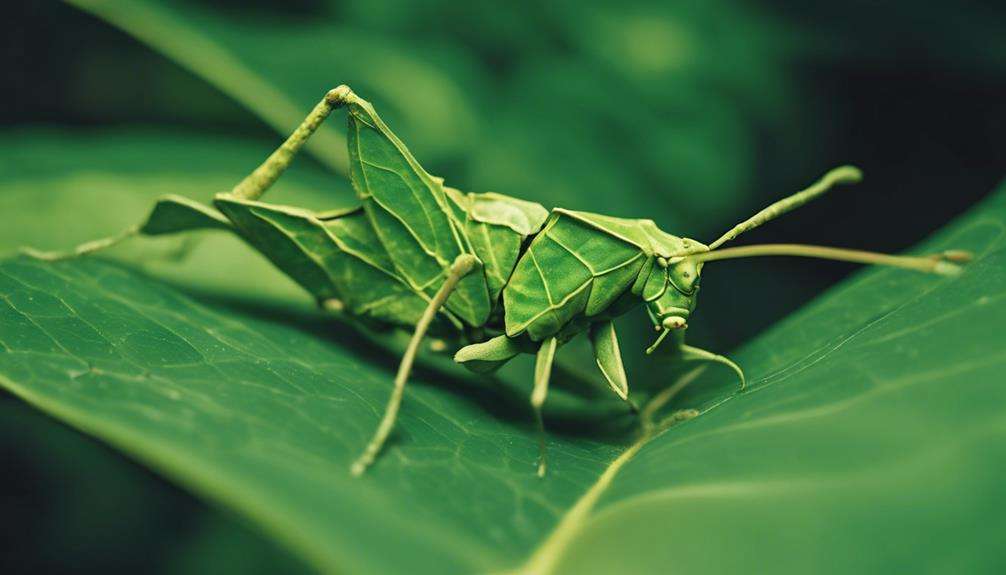
Leaf insects, like stick insects, exhibit fascinating characteristics closely tied to their leaf-mimicking behavior. These quirky companions boast a unique appearance that closely resembles the structure and coloration of leaves, making them a visually intriguing addition to your home. To accommodate their climbing nature, leaf insects require spacious terrariums with ample vertical space for them to move around comfortably. Their diet, consisting of berries and leaves, is carefully curated to replicate their natural habitat and ensure their well-being.
Observing leaf insects in their habitat can be a mesmerizing experience, as they showcase remarkable camouflage skills that allow them to blend seamlessly with foliage. The intricate details of their leaf-like bodies, including vein-like patterns and irregular edges, further highlight the marvel of nature's mimicry. By providing a suitable environment and diet, you can enjoy the enchanting presence of leaf insects as they add a touch of nature's magic to your living space.
Millipedes: Curious Insect Friends
With their segmented bodies and intriguing behavior, millipedes offer a captivating glimpse into the world of arthropods as curious insect friends. These small insects, although not technically insects, are interesting pets to observe due to their unique movements and segmented bodies. Here are three reasons why millipedes can make fascinating additions to your terrarium:
- Easy to Care: Millipedes are relatively easy to care for, requiring a habitat with moist substrate and leaf litter for tunneling. They feed on decaying plant matter, making their diet simple and inexpensive to maintain.
- Fascinating Behavior: Millipedes showcase fascinating behavior by creating burrowing tunnels in leaf litter, mimicking their natural habitat preferences. Observing them in this environment can provide insight into their natural instincts and behaviors.
- Inexpensive to Care: Compared to other exotic pets, millipedes are inexpensive to care for. Their requirements are minimal, making them a cost-effective option for those looking to explore the world of arthropods as pets.
Frequently Asked Questions
What Is the Best Insect to Have as a Pet?
For a unique companion, consider a praying mantis. You'll develop an interactive bond through their predatory behavior. They're a low maintenance option and fascinating critters to observe with their intriguing appearance and hunting techniques.
What Insects Like to Be Held?
For insects that enjoy being held, consider friendly beetles, cuddly caterpillars, sociable stick insects, and playful millipedes. They exhibit behaviors indicating comfort with handling, making them suitable for interaction and observation.
Are There Any Affectionate Insects?
Insects like stick insects, beetles, praying mantises, and Madagascar hissing cockroaches can exhibit bonding behavior, social interactions, playful tendencies, and unique personalities towards their owners. Their affectionate nature often surprises and delights caretakers.
What Is the Easiest Bug to Take Care Of?
Stick insects are the easiest bugs to care for. They require minimal maintenance, are affordable, and apartment-friendly. They offer an interactive, child-friendly, and educational experience. Their unique camouflage abilities make them entertaining pets to observe.
Conclusion
In conclusion, have you ever considered the diverse world of insect pets?
From the striking beauty of beetles to the graceful predators like praying mantises, there are endless possibilities for unique and fascinating companions.
With their intriguing behaviors and captivating appearances, these insects offer a new perspective on the world of pet ownership.
So why not explore the wonders of insect companionship and dive into the enchanting realm of these curious creatures?
